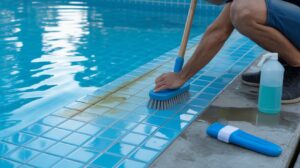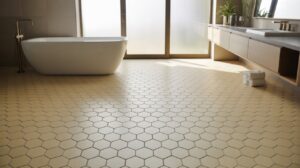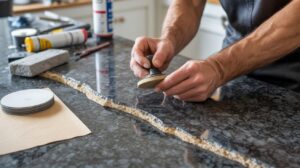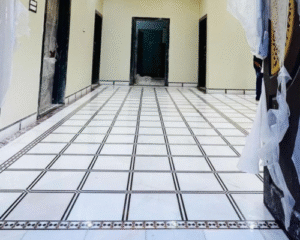How to polish marble floors is a question many homeowners ask when their once-glossy surfaces begin to look dull and worn. Marble floors are known for their timeless beauty, but without proper maintenance, they can lose their luxurious appeal. At SF Marble & Granite Inc., we specialize in helping homeowners protect and enhance the natural brilliance of their marble flooring. In this guide, you’ll discover the importance of polishing marble floors, the tools and techniques needed, and whether to tackle the job yourself or rely on professional help. Let’s help you bring back the shine your marble deserves.
Understanding Marble as a Natural Stone

Knowing how to polish marble floors starts with understanding marble itself. As a soft, porous stone, marble brings beauty and elegance, but it also needs special care to maintain its shine. At SF Marble and Granite, we help homeowners protect and restore marble surfaces, whether it’s classic flooring or stylish blue hexagon and hexagon tile patterns.
Table of Contents
ToggleComposition and Characteristics of Marble
- Soft, porous stone made from limestone.
- Naturally veined and uniquely patterned.
Due to its calcium-based makeup, marble is more fragile than granite or quartz and can become scratched or stained without proper care and maintenance.
Why Marble Floors Lose Their Shine Over Time
- Foot traffic causes surface wear.
- Spills and harsh cleaners dull the finish.
Over time, even carefully maintained marble floors may lose their gleam. Regular polishing and maintenance help restore them back to their former gleam, and protect against further long-term damage.
Signs Your Marble Floor Needs Polishing
Noticing your floor has lost its glow? Knowing how to polish marble floors starts with spotting the early signs. At SF Marble and Granite, we help restore shine to floors around busy areas like the kitchen island or near elegant green countertops installation
Dullness and Surface Etching
- The floor looks cloudy or chalky in spots.
Acidic spills or regular wear and tear can leave marble tiles looking discolored and faded over time, even with diligent cleaning efforts. Unfortunately, once etching has set in, it’s nearly impossible to restore their former splendor.
Scratches, Stains, and Watermarks
- Visible marks or water rings that won’t fade.
Stains from spills or scratches from dirt build up over time, especially in high-use areas.
Loss of Natural Shine and Luster
- Clean but still looks flat and worn.
If your floor lacks that smooth, glossy finish, it’s time to polish. It also protects the value, especially when you’ve invested in premium materials where the cost of a marble floor matters.
Tools and Materials Required for Marble Floor Polishing
Being able to polish marble floors requires having access to quality equipment and supplies in order to avoid damage and ensure long-lasting results. At SF Marble and Granite, we advise investing in top-of-the-line equipment so as to minimize possible future repairs while maximizing results – whether buffing marble floors yourself or hiring professional service providers, these tools will bring back its beautiful shine!
Floor Buffer, Polishing Powder, and Microfiber Pads
- A floor buffer smooths out scratches and enhances shine.
- Polishing powder helps remove light etching and dull spots.
- Microfiber pads apply products evenly without scratching the surface.
These basic tools are great for homeowners conducting light polishing themselves in low traffic areas or small sections of marble flooring.
Marble Sealer and Protective Gear
- A sealer protects against moisture, stains, and future wear.
- Gloves, eye protection, and a mask ensure safe handling of chemicals.
Sealing is a must after polishing. It prevents future problems like spills or deep stains that are hard to fix later.
Optional: Commercial Marble Polishing Machines
- Used by professionals for large or heavily worn areas.
If you’re unsure about the difference in materials when polishing, remember that marble is more delicate than other stones. Many confuse quartz with quartzite, but marble is softer and needs gentler tools. When buffing marble floors, the right equipment helps restore that smooth, glossy finish without damage.
Step-by-Step Guide: How to Polish Marble Floors by Hand or Machine
Discovering how to polish marble floors may appear daunting at first, but with the appropriate steps and tools it’s actually much simpler than you expect. Your goal should always be to restore its natural shine without damaging its surface; at SF Marble and Granite we have helped many homeowners who asked themselves “how can I polish marble floors” achieve stunning results themselves or sought our professional help with incredible success.
Cleaning and Preparing the Surface
- Start by sweeping and mopping the floor thoroughly.
- Remove all dirt, dust, and grime before polishing.
Use a pH-neutral cleaner to avoid etching. If you’ve recently installed marble or it’s been in place for years, cleaning is the most important first step. Dirt and sand can scratch the surface during polishing, so make sure it’s spotless.
Applying Polishing Compound or Powder
- Use a marble-safe polishing powder or cream.
- Apply with a damp microfiber cloth or pad.
Gently rub the product into the stone using circular motions. If you’re searching for marble slabs near me and want to maintain their look after installation, this is a crucial maintenance step.
Buffing the Floor (Manual vs Machine Method)
- Hand buffing works for small areas or light touch-ups.
- Use a low-speed floor buffer for larger or duller areas.
Buffing marble floors helps remove minor scratches and restore their gloss. Be gentle if working manually; machine buffing should move steadily to prevent swirl marks.
Rinsing, Drying, and Sealing
- Wipe away any residue with a clean, damp cloth.
- Let the floor dry completely before sealing.
Apply a marble sealer to protect the stone against water, stains, and wear. Sealing locks in your polishing efforts over the long run.
Post-Polishing Care and Maintenance Tips
Once you know how to polish marble floors, they must remain shiny with proper maintenance. Regular upkeep makes an enormous difference for new or older installations of this surface.
Daily and Weekly Cleaning Tips
- Dust mop daily and use a damp mop weekly.
- Avoid harsh or acidic products when cleaning marble tile.
Stick to pH-neutral cleaners to protect the polished surface from dulling or etching.
Best Cleaners for Polished Marble
- Use marble-safe or stone-specific cleaners only.
Avoid vinegar, bleach, or ammonia; they can ruin the finish.
When to Re-Polish
- Re-polish every 12–18 months or when dull spots appear.
If your floor looks flat even after cleaning, it’s time to revisit how to polish marble floors for a fresh shine.
Why Choose SF Marble & Granite Inc.
When it comes to expert care and knowing how to polish marble floors the right way, SF Marble & Granite Inc. stands out in Lowell, MA. We combine years of hands-on experience with deep knowledge of natural stone care, especially in marble floor installation and restoration.
Trusted Experience and Craftsmanship
- Over a decade of polishing and installing marble floors in homes and businesses.
- Skilled technicians who understand marble’s delicate nature.
Proven Results and Happy Clients
- A strong portfolio of polished, glowing marble floors.
- Local homeowners trust us for long-lasting results.
Free Consultation and Quality Guarantee
- We offer clear advice before every project.
- Your satisfaction is backed by our service guarantee.
No matter if it’s new installations or refurbishing existing floors, our expert staff are here to help you learn how to polish marble floors confidently and with care.
Final Thought
Now that you understand how to polish marble floors, it’s time to take the next step—whether that means trying a DIY approach for small touch-ups or calling in the pros for a full restoration. Regular polishing not only brings back the natural shine but also protects your investment in marble flooring. With the right tools, care, and technique, you can keep your marble looking elegant for years to come.
If you’d rather leave the work to experts, SF Marble & Granite Inc. is here to help. We specialize in marble floor installation and professional polishing services across Lowell, MA. Contact us today for a free consultation and let us restore the beauty and brilliance of your marble floors get started now with SF Marble & Granite Inc.!
FAQs
How often should I polish my marble floors?
It depends on foot traffic, but most marble floors benefit from polishing every 12 to 18 months. High-traffic areas like kitchens or entryways may need more frequent polishing to maintain shine.
Can I polish marble floors myself, or should I hire a professional?
If you’re dealing with light dullness or small areas, DIY polishing is possible with the right tools. For deeper scratches or larger spaces, it’s best to consult professionals like SF Marble & Granite Inc. for long-lasting results.
What’s the best way to keep marble floors clean after polishing?
Use a pH-neutral cleaner and avoid acidic products like vinegar or lemon. Regular dust mopping and gentle cleaning of marble tile will help maintain the polished finish and prevent wear.







